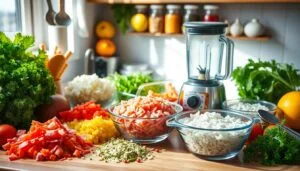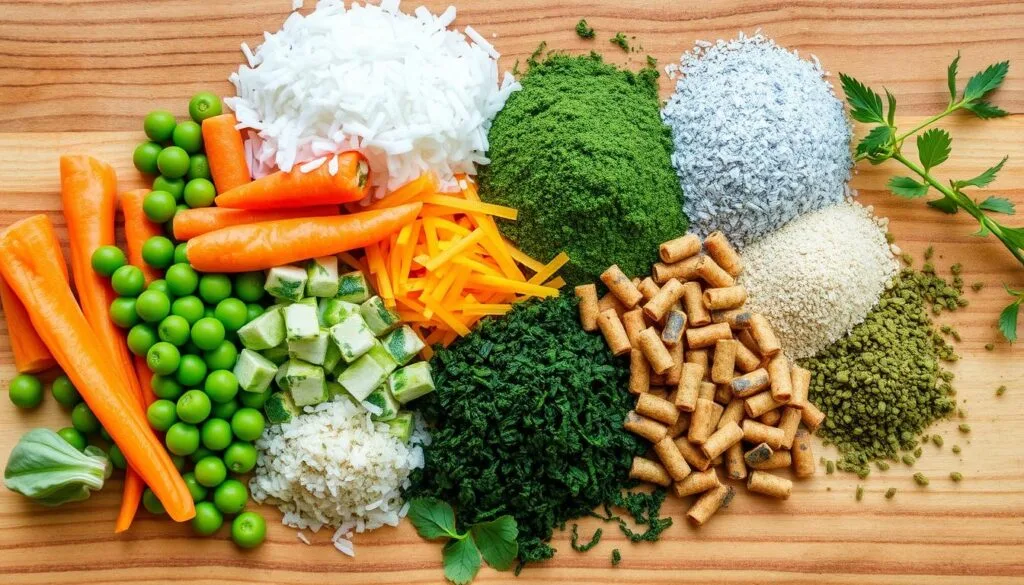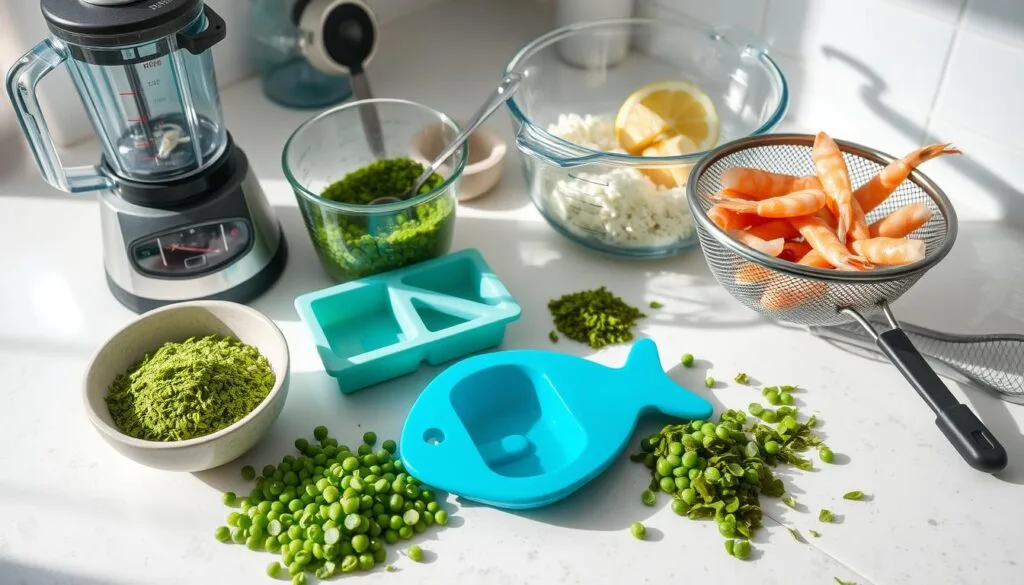The Best Fluffy Pancakes recipe you will fall in love with. Full of tips and tricks to help you make the best pancakes.

As an aquarium enthusiast, I know how crucial a good diet is for your fish. Commercial food is easy, but making your own is rewarding. This guide will show you how to make healthy, tasty fish food at home.
Key Takeaways
- Discover a range of simple, yet nutrient-rich fish food recipes you can prepare at home
- Learn about the essential ingredients and storage methods for homemade fish food
- Explore diverse options, from pellets and gel food to live cultures and occasional treats
- Understand the benefits of providing your fish with a customized, healthy diet
- Gain the confidence to take control of your aquarium’s feeding regimen
Homemade Fish Food Recipes for a Healthier Aquarium Diet
Keeping your aquarium fish healthy starts with their diet. Homemade fish food is a better choice than store-bought flakes or pellets. It gives your fish the right mix of nutrients for their well-being.
Nutrient-Rich Ingredients for Homemade Fish Pellets
Choosing the right ingredients is key to making healthy fish pellets. Some top picks include:
- Spirulina: It’s packed with protein, vitamins, and minerals that boost immune health and color.
- Shrimp or fish meal: These provide important amino acids and protein for your fish.
- Vegetables and plant matter: They add fiber, vitamins, and minerals for a balanced diet.
Tips for Preparing and Storing Homemade Fish Food
Getting your homemade fish food right is important. Here are some tips:
- Mix and bind the ingredients well to get a pellet texture.
- Dry the pellets completely to avoid spoilage and mold.
- Keep the finished food in airtight containers in the fridge or freezer for longer life.
Preparing homemade fish food takes time, but it’s worth it. Your fish will be healthier and more vibrant. Try different ingredients to meet your fish’s specific needs.
DIY Tropical Fish Meals: Gel Food and Frozen Options
Aquarium owners can make their own fish food instead of buying it. Gel-based and frozen tropical fish meals are two DIY favorites. They are full of nutrients and easy for fish to digest, just like live food.
Homemade Gel Fish Food
Gel food recipes use mostly water, needing just a few tablespoons a day for most fish. A small amount of medicine is added, making it easy to treat your fish. Some recipes make a lot of medicated food, while others use more medicine for better results.
Frozen Fish Food Options
Making frozen fish food at home lets you use healthy ingredients like peas, spinach, and carrots. You can also add protein sources like raw shrimp or fish fillets. This frozen food gives your fish a natural, live food experience.
Whether you make gel or frozen food, store it well in airtight containers. Keep it cool in the fridge or freezer. Use it within a month to keep it fresh and full of nutrients.
It’s important to give your fish a varied, nutritious diet for their health and long life. Trying DIY tropical fish meals can be a fun way to meet your fish’s special dietary needs.
Live Fish Food Recipes You Can Grow at Home
For aquarium lovers, growing your own live fish food at home is rewarding. You can culture brine shrimp and micro-worms to feed your fish naturally. These tiny creatures are packed with vitamins, minerals, and proteins that boost your fish’s health.
Culturing Brine Shrimp and Micro-worms
Brine shrimp and micro-worms are top choices for homemade live fish food. Brine shrimp, or Artemia, are rich in protein and great for many fish. Micro-worms, tiny nematode worms, are perfect for fry and small fish.
It’s easy to set up and care for cultures of brine shrimp and micro-worms. With the right setup, you can always have these live fish food sources ready for your fish.
Growing Daphnia and Other Livebearer Cultures
You can also grow daphnia and livebearer species at home. Daphnia, or water fleas, are a nutritious snack for many fish, especially fry and small tetras. Livebearers, like guppies and mollies, can be raised as live food, offering a natural, protein-rich treat.
Starting and caring for these live fish food cultures needs some planning and attention. But, the benefits of having fresh, nutritious live foods for your fish are huge.
Easy Fish Treat Recipes for Occasional Feedings
While a balanced homemade diet is key, treats can add variety and fun. This section offers simple recipes for fish treats like frozen fruit cubes and veggie snacks. These can be great additions to your fish’s main meals.
Frozen Fruit Cubes
Frozen fruit cubes are a favorite among many fish. Just mix your fish’s favorite fruits like mango, pineapple, or strawberries. Pour the mix into an ice cube tray and freeze until solid.
Then, pop out the cubes and give them to your fish during meals. As they melt, they offer a cool, hydrating snack.
Veggie Bites
- Lightly steam or boil chopped veggies like zucchini, carrots, or spinach until tender.
- Blend the veggies into a smooth paste and spread it on a baking sheet.
- Freeze the sheet until the bites are firm, then break them into small pieces.
- Store the homemade fish treats in the freezer and add a few to your fish’s meals.
These healthy fish treats are full of vitamins and minerals. They can boost your fish’s health and energy.
While these DIY fish food treats are fun, they should be given in moderation. Always follow the recommended serving sizes. Keep your fish’s main diet nutritious and varied for their best health.
fish food recipe: Versatile Fish Pellet Base Recipe
Making homemade fish pellets can change the game for your aquarium or pond. This recipe lets you tailor the food to your fish’s needs. Whether they’re herbivores, carnivores, or omnivores, you can make a healthier, cheaper option than store-bought food.
The recipe centers on protein-rich ingredients like fish meal, soybean meal, or spirulina. These are key for your fish’s growth and health. We also add vegetable oils or fish oil for the fats and fatty acids they need.
A starch like wheat flour or gelatin helps hold the pellets together. It also adds fiber, which is good for your fish’s digestion and health.
Lastly, we mix in a balanced set of vitamins and minerals. This ensures your fish get all the nutrients they need for growth and health.
By following this simple recipe, you can make a nutritious, customizable diet for your fish. It will help keep them healthy and active in your aquarium or pond.
Ingredients for Homemade Fish Pellets
- 2 cups fish meal or soybean meal
- 1/2 cup vegetable oil or fish oil
- 1/2 cup wheat flour or gelatin
- 1/4 cup vitamin and mineral supplement
- 1/4 cup spirulina powder (optional)
Instructions for Making Homemade Fish Pellets
- In a large mixing bowl, combine the fish meal (or soybean meal), vegetable oil (or fish oil), and wheat flour (or gelatin).
- Add the vitamin and mineral supplement, and if desired, the spirulina powder. Mix all the ingredients thoroughly until well combined.
- Using a meat grinder or a pellet press, extrude the mixture into small pellets. Adjust the size of the pellets to suit the needs of your fish.
- Spread the pellets on a baking sheet and allow them to dry completely, which may take several hours or overnight.
- Once dried, store the homemade fish pellets in an airtight container in a cool, dry place. They can be kept for up to a year, providing a cost-effective and nutritious option for your aquarium or pond.
You can customize this base recipe with extra ingredients. Try adding diced veggies, seafood, or even Black Soldier Fly larvae. This way, you can make a variety of homemade fish foods that meet your fish’s specific needs.
Healthy Fish Food Alternatives to Commercial Flakes
Commercial fish flakes are easy to use but might not be the best for your fish. You can make better food for them with fresh, whole ingredients. These can meet the specific needs of your fish.
Vegetable-Based Recipes for Herbivorous Fish
Herbivorous fish like tetras, mollies, and plecos need lots of plant nutrients. You can add healthy veggies to their food. Try these recipes:
- Spirulina wafers: Mix spirulina powder, cooked sweet potato, and chia seeds. Shape into a paste, then dry it into wafers.
- Blanched vegetable purees: Steam and puree kale, spinach, and zucchini. Add a binder like agar-agar or gelatin.
These vegetarian foods give your herbivorous fish the vitamins, minerals, and fiber they need.
Protein-Rich Options for Carnivorous Species
Carnivorous fish, such as cichlids and predatory tetras, need more protein. Use these protein-rich ingredients in their food:
- Freeze-dried shrimp or krill: Crush it into a powder and mix with a binder.
- Fish-based pellets: Mix pureed fish, fish oil, and other nutrients. Dehydrate into pellets.
- Egg yolk: Boil, then crush.It’s a great of protein and healthy fats.
These high-protein foods will help your carnivorous fish stay healthy and active.

Fish Food Ingredients to Avoid and Safe Substitutes
When making homemade fish food, it’s important to know which ingredients are bad for your fish. Knowing what to avoid and what to use instead helps keep your fish healthy and well-fed.
Mycotoxins are harmful to fish and can cause weight loss, poor growth, and weakened immunity. Always choose mold-free ingredients for your fish food.
Also, avoid artificial colors and additives because they can be harmful. Instead, use natural colors like spirulina and astaxanthin.
Fish meal is not the best protein source because it comes from leftover fish parts. Use better protein sources like whole fish or shrimp instead.
Lastly, grains and fillers can be hard for fish to digest and cause waste problems. Use ingredients that are easier to digest and full of nutrients.
| Ingredient to Avoid | Safe Substitute |
|---|---|
| Mycotoxins | High-quality, mold-free ingredients |
| Artificial colors and additives | Natural color enhancers (e.g., spirulina, astaxanthin) |
| Fish meal | Whole fish or shrimp |
| Grains and fillers | Digestible, nutrient-rich ingredients |
By avoiding bad ingredients and using safe alternatives, you can make homemade fish food that’s good for your fish. This helps keep them healthy and happy.
Essential Equipment for Making Fish Food at Home
Making fish food at home needs special tools. You’ll need them to make pellets, flakes, or gel treats. The right equipment helps you make a balanced diet for your fish.
Blenders and Food Processors
A good blender or food processor is key. They should handle tough ingredients like spirulina powder and fish meal well. Choose one with a strong motor.
Molds and Trays
You’ll need molds and trays to shape your fish food. Silicone ice cube trays or baking sheets are perfect for small pellets.Cookie cutters can make fun shapes too.
.
Dehydrators and Ovens
To dry fish flakes or pellets, use a dehydrator or oven. Set it to a low temperature. This removes moisture, making the food crunchy and shelf-stable.
| Equipment | Purpose |
|---|---|
| Blender or Food Processor | Mixing and grinding ingredients |
| Molds and Trays | Shaping homemade fish food |
| Dehydrator or Oven | Drying and preserving fish food |
With the right equipment for homemade fish food and diy fish food supplies, you can make healthy meals for your fish. This ensures their health and happiness.

Conclusion: Benefits of Homemade Fish Foods
Making fish food at home has many benefits. You get to choose what goes into your fish’s meals. This means you can give them a diet that’s just right for them.
Homemade fish food is also cheaper than buying it. This lets you save money while feeding your fish the best food. It’s a win-win situation.
Another great thing about homemade fish food is avoiding bad stuff. Commercial foods often have additives and preservatives. But homemade food lets you skip those. This makes your fish healthier and helps the planet too.
So, if you want to save money or give your fish the best diet, try making fish food at home. It’s good for your fish and the planet.









